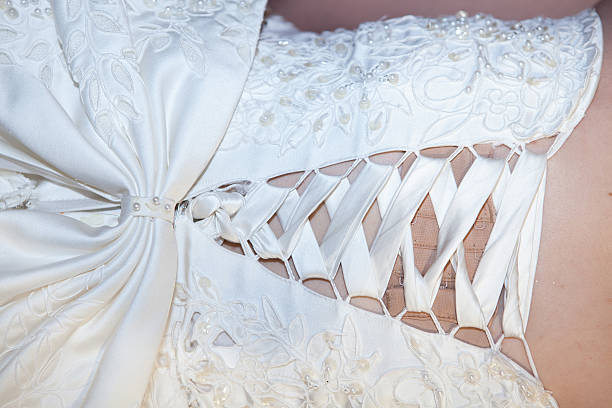Explore helpful tips on non-traditional wedding dresses
Breaking away from classic white gowns has become a powerful way for couples to express their unique love stories. Non-traditional wedding dresses offer endless possibilities, from bold colors to unconventional silhouettes, allowing you to celebrate your special day in a way that truly represents who you are. This guide provides practical advice for choosing a dress that reflects your personality while ensuring comfort and confidence throughout your celebration.

Discover Unique Styles That Reflect Your Personality
Your wedding dress should be an extension of your personal style rather than a costume you wear for a day. Non-traditional options range from sleek jumpsuits and tailored pantsuits to tea-length dresses and bohemian separates. Consider your everyday fashion preferences as a starting point. If you typically gravitate toward minimalist aesthetics, a simple slip dress in luxurious fabric might feel more authentic than a heavily embellished ball gown. For those who love vintage fashion, exploring styles from different eras can yield stunning results. Art deco beading, 1970s crochet details, or 1950s tea-length silhouettes offer timeless elegance with a distinctive twist. The key is selecting something that makes you feel like the best version of yourself rather than conforming to traditional expectations.
Explore Vibrant Colors and Innovative Fabrics
Color has become one of the most popular ways to personalize wedding attire. Soft blush and champagne tones provide subtle departure from pure white, while bolder choices like emerald green, deep burgundy, or even black make striking statements. Metallics such as gold, silver, and rose gold add glamour and photograph beautifully. When selecting color, consider your skin tone, the season of your wedding, and your overall aesthetic vision. Fabric choice is equally important for achieving your desired look. Innovative materials like sustainable hemp silk, recycled polyester, and organic cotton appeal to environmentally conscious couples. Textured fabrics such as velvet, brocade, and jacquard add visual interest and work particularly well for fall and winter celebrations. Lightweight options like chiffon, georgette, and tulle remain popular for warmer months and outdoor ceremonies. Many designers now combine unexpected materials, creating unique pieces that challenge traditional wedding fashion norms.
Find the Perfect Dress for Any Wedding Theme
Your dress should complement your overall wedding vision rather than clash with it. Beach ceremonies call for flowing fabrics and relaxed silhouettes that move gracefully in coastal breezes. Garden weddings pair beautifully with floral embroidery, nature-inspired details, and romantic, ethereal styles. Urban celebrations in industrial spaces or modern venues provide opportunities for edgier choices like structured separates, asymmetrical hemlines, or architectural designs. Rustic barn weddings accommodate everything from lace bohemian gowns to casual cotton dresses paired with boots. Destination weddings require practical considerations alongside style preferences. Choose fabrics that travel well, resist wrinkling, and suit the local climate. For themed weddings, whether vintage, cultural, or fantasy-inspired, research authentic details that honor the theme while maintaining your personal comfort and style preferences.
Get Practical Tips for Your Dress Selection
Start your search early, ideally six to nine months before your wedding date, to allow time for ordering, alterations, and any unexpected challenges. Set a realistic budget that includes the dress, alterations, undergarments, and accessories. Non-traditional dresses often cost less than conventional bridal gowns, but custom pieces or designer options can still represent significant investments. Shop with trusted friends or family members who understand your style and will provide honest feedback. However, limit your entourage to avoid overwhelming opinions that might cloud your judgment. Try on various silhouettes even if they differ from your initial vision. You might discover unexpected favorites. Take photos from multiple angles to review later with fresh perspective. Consider the practical aspects of your chosen dress. Can you sit comfortably? Dance freely? Navigate stairs safely? Will you need bustle options for the reception? These functional considerations ensure you enjoy your celebration without wardrobe concerns. Schedule fittings strategically, with your final fitting occurring close to the wedding date to accommodate any last-minute body changes.
Embrace Individuality on Your Special Day
Choosing a non-traditional wedding dress represents more than fashion preference. It reflects confidence in your unique identity and willingness to celebrate your relationship authentically. Many couples find that breaking from convention in their attire sets a tone of creativity and personal expression that extends throughout their entire celebration. Your dress choice might inspire guests to feel more comfortable expressing their own styles, creating a more relaxed and genuine atmosphere. Remember that your wedding photos will document this moment for decades. Select something that represents who you truly are rather than who you think you should be. Trends fade, but authentic self-expression remains timeless. If you feel uncertain about straying too far from tradition, consider compromise options. A white dress with colored embroidery, a traditional silhouette in an unexpected fabric, or classic styling with bold accessories can bridge conventional and contemporary aesthetics. Ultimately, the perfect non-traditional wedding dress is one that makes you feel confident, comfortable, and genuinely excited to wear it on your special day.
Creating Your Complete Look
Once you have selected your dress, focus on complementary elements that complete your vision. Accessories offer opportunities for additional personalization. Statement jewelry, unique footwear, non-traditional veils or headpieces, and distinctive outerwear for outdoor ceremonies all contribute to your overall aesthetic. Consider how your dress photographs in various lighting conditions and settings. Bring it to your venue if possible for test photos. This preparation helps identify any needed adjustments and ensures you feel confident about how you will appear in your wedding documentation. Communicate clearly with your photographer about capturing details that matter most to you, whether intricate fabric textures, color variations, or unique design elements. Finally, arrange for proper dress care both before and after your wedding. Professional cleaning and preservation services help maintain your gown as a cherished keepsake, regardless of its unconventional nature.


